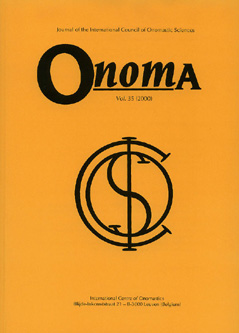 previous article in this issue previous article in this issue | next article in this issue  |

Preview first page |
Document Details : Title: Croatian Medieval and Early Modern Anthroponymy Subtitle: Evidence of Migrations and Cultural and Linguistic Influences Author(s): BRGLES, Branimir Journal: Onoma Volume: 49 Date: 2014 Pages: 53-76 DOI: 10.2143/ONO.49.0.3285498 Abstract : The article focuses on Croatian historical anthroponymy and the development of methodology in the fields of history and onomastics. The author’s interest is aimed at the possibilities of interdisciplinary research and the use of special kinds of pre-statistical historical sources (church tithe records, manorial urbaria, lists of peasants and serfs etc.). While these documents are a rich source for the research of social and economic history, the author is also interested in assessing the possibilities of their use in research on the historical anthroponomastics of the late medieval and early modern Kingdom of Croatia-Slavonia. A number of these historical documents were transcribed into a database during interdisciplinary historical-onomastics research. This extensive database consists of 25,000 individual records, including attestations of historical anthroponyms. These anthroponymical attestations provided examples of many distinctive types of bynames and surnames. For example, a number ethnonyms, locative bynames and bynames motivated by a variety of work related activities were found in many of these documents. Many of anthroponyms attest to the multitude of migration routes that extended through most of the late-medieval Kingdom of Croatia-Slavonia, and branched out in many different directions. The fact that the Kingdom of Croatia-Slavonia was located at the periphery of the Habsburg Empire, and a large part of its territory was divided among three influential cultural centres and overlapping military-political spheres caused many different linguistic and cultural influences, which are apparent in Croatian onomastics. Consequentially, a close analysis of the described historical data uncovered abundant evidence of different linguistic influences in anthroponymic attestations. The majority of the influences discovered were German and Hungarian. There were also some language influences from the Apennine peninsula, and some less evident Ottoman influences. L’article traite de l’anthroponymie historique croate, et du développement de la méthodologie en Histoire et en Onomastique. L’intérêt de l’auteur porte sur les possibilités d’une recherche interdisciplinaire et l’utilisation de sortes de sources historiques pré-statistiques (actes dîmaires ecclésiastiques, urbaria seigneuriaux, listes de paysans et serfs, etc.). Alors que ces documents constituent une source riche pour la recherche en histoire sociale et économique, l’auteur a tenté d’évaluer les possibilités de leur emploi pour l’anthroponymie historique du royaume de Croatie-Slavonie à la fin du Moyen Âge et au début de l’ère moderne. Nombre de ces documents ont été transcrits dans une base, dans le cadre d’une recherche interdisciplinaire Histoire/Onomastique. Cette importante base réunit quelque 25.000 données individuelles, comprenant les attestations anciennes des anthroponymes. Celles-ci fournissent de nombreux types de surnoms et de noms de famille: par exemple, nombre d’ethnonymes, de surnoms locatifs, ou motivés par un métier ou une activité. Beaucoup de noms témoignent de la multitude des voies de migration dans la majeure partie du royaume et de leur extension dans de nombreuses directions différentes. Le fait que le royaume fût situé à la périphérie de l’Empire des Habsbourg, une grande partie de son territoire partagée entre trois centres d’influences culturelles et des aires politico-militaires entrecroisées entraîna la création de nombreuses influences linguistiques et culturelles différentes qui transparaissent dans l’onomastique croate. C’est pourquoi l’analyse minutieuse des données historiques a apporté la preuve abondante de ces influences dans les attestations anthroponymiques. Elles sont surtout germaniques et hongroises. Cependant il y en eut d’autres, d’origine apennine, mais aussi ottomanes moins évidentes. Der Artikel beschäftigt sich mit historischer kroatischer Anthroponymie und der Methoden-Entwicklung im Bereich der Geschichte und Onomastik. Das Interesse des Autors richtet sich auf Möglichkeiten interdisziplinärer Forschung und der Verwendung bestimmter vor-statistischer geschichtlicher Quellen (kirchliche Aufzeichnungen über Grundzinsen, grundherrschaftliche Urbarien, Verzeichnisse über Bauern und Leibeigene etc.). Während diese Dokumente eine reiche Quelle für Forschung über Sozial- und Wirtschaftsgeschichte darstellen, bewertet der Autor auch die Möglichkeiten ihrer Verwendung in der Forschung zu historischer Anthroponomastik des späten Mittelalters und des frühmodernen Königreichs Kroatien-Slawoniens. Eine Reihe dieser historischen Dokumente wurden im Zuge der interdisziplinären historisch-onomastischen Forschung in eine Datenbank eingepflegt. Diese umfassende Datenbank besteht aus 25 000 einzelnen Einträgen, darunter befinden sich auch historische Anthroponyme. Diese anthroponymischen Belege lieferten Beispiele für viele unterschiedliche Typen von, Bei-, Zu- und Familiennamen. Eine Reihe von Ethnonymen, lokalen Beinamen und Beinamen, die aus Aktivitäten der Arbeitswelt entstammen, wurden in vielen dieser Dokumente gefunden. Viele Anthroponyme zeugen von den vielfältigen und weitverzweigten Migrationsrouten, die sich über große Teile des spätmittelalterlichen Königreichs Kroatien-Slawonien erstreckten. Die Tatsache, dass das Königreich Kroatien-Slawonien an der Peripherie des Habsburgerreiches gelegen war, und weite Teile seines Territoriums auf drei kulturell einflussreiche Zentren und militärisch politisch überlappende Sphären aufgeteilt waren, verursachte viele unterschiedliche sprachliche und kulturelle Einflüsse, die in der kroatischen Onomastik offensichtlich sind. In der Folge zeigte eine Analyse der beschriebenen historischen Daten Beweise für verschiedene sprachliche Einflüsse in anthroponymischen Belegen. Die Mehrheit der nachgewiesenen Einflüsse waren deutsch und ungarisch. Zudem fanden sich Einflüsse der Apenninenhalbinsel und einige wenige offensichtliche ottomanische Einflüsse. |
|


